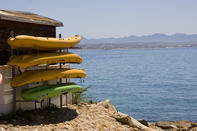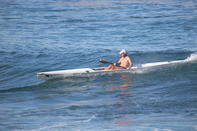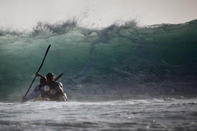History
It is common knowledge that the ancient Inuit and Aleut tribes were the first people to perfect the concept of kayaking.

These early kayaks, manufactured from skins stretched over frames constructed from wood or bone, were used for transport, hunting and fishing. In fact, the word ‘kayak’ means ‘hunter’s boat’ in the Greenlandic language.
Dugouts, or canoes made from hollowed tree trunks, were used in warmer climes for similar purposes, and it is thought that they were first made by Native American Indians.
Recreational paddling took a while to become popular though, and it was only during the mid- 1800s that it caught on in Europe. The Royal Canoe Club of London was one of the first paddling clubs, and by 1936 both canoe and kayak events had officially been included in the Olympic Games.
Equipment

Riding a wave in a rodeo kayak provides as much pleasure as any safari, but you must decide on a suitable kayak before you take on the tides. This is easier said than done, as this watercraft comes in a bewildering range of shapes and sizes. Your main call would be between either a traditional sit-in kayak (difficult to balance) or a more stable sit-on design.
Manufacturing technology has progressed in leaps and bounds since the days of animal skin kayaks, with contemporary craft generally made up of polythene, polycarbonate or fiberglass compounds. Then you need to decide whether you will be blading solo or with a partner and narrow it down to a single-seater or double kayak.
Plus, there are endless other design considerations which will influence the handling and performance of your kayak, from the shape and width of the beam, the length of the hull, the angle of the keel, the type of steering mechanism, the cockpit configuration and the overall volume of the kayak. All these characteristics will affect the tracking, speed, weight, stability and handling of your craft, so try it before you buy it.
Guidelines

As with most recreational adventure activities, paddlers should follow tried and tested guidelines in order to ensure their safety and also instil an environmentally friendly approach within the great outdoors.
Safety should be top of mind, so never set off on a kayak trip without getting a medium term weather forecast; always wear a personal flotation device (PFD) and be sure to carry emergency equipment such as a medical kit and signal flares.
Protect yourself from the elements by slapping on ample sunscreen, wearing protective clothing and by packing dry gear in a watertight container to counter hypothermia once the big chill rolls in. Know your distress signals, be sure you can competently handle your craft in rough seas and, above all, respect your fellow outdoor enthusiasts and the environment.